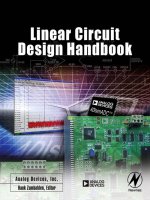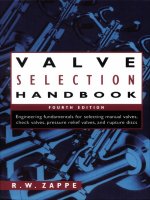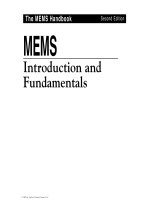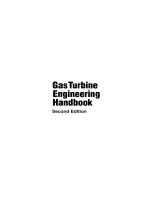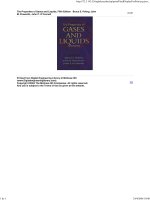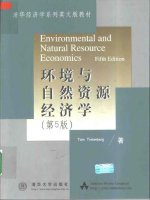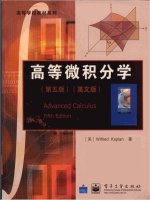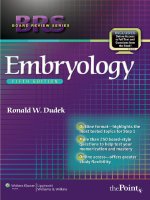valve selection handbook, fifth edition
Bạn đang xem bản rút gọn của tài liệu. Xem và tải ngay bản đầy đủ của tài liệu tại đây (20.1 MB, 404 trang )
VALVE
SELECTION
HANDBOOK
FIFTH EDITION
TLFeBOOK
VALVE
SELECTION
HANDBOOK
FIFTH EDITION
Engineering fundamentals for selecting the right
valve design for every industrial flow application
By
PETER SMITH
(Editor and Contributor)
and
R. W. ZAPPE
AMSTERDAM • BOSTON • LONDON • NEW YORK • OXFORD • PARIS
SAN DIEGO • SAN FRANCISCO • SINGAPORE • SYDNEY • TOKYO
Gulf Professional Publishing is an imprint of Elsevier Inc.
TLFeBOOK
Gulf Professional Publishing is an imprint of Elsevier
200 Wheeler Road, Burlington, MA 01803, USA
Linacre House, Jordan Hill, Oxford OX2 8DP, UK
Copyright © 2004, Elsevier, Inc. All rights reserved.
No part of this publication may be reproduced, stored in a retrieval system, or transmitted
in any form or by any means, electronic, mechanical, photocopying, recording, or
otherwise, without the prior written permission of the publisher.
Permissions may be sought directly from Elsevier’s Science & Technology Rights
Department in Oxford, UK: phone: (+44) 1865 843830, fax: (+44) 1865 853333,
e-mail: You may also complete your request on-line via the
Elsevier Science homepage (), by selecting “Customer Support” and
then “Obtaining Permissions.”
Recognizing the importance of preserving what has been written, Elsevier prints its
books on acid-free paper whenever possible.
Library of Congress Cataloging-in-Publication Data
Application submitted
British Library Cataloguing-in-Publication Data
A catalogue record for this book is available from the British Library.
ISBN: 0-7506-7717-1
For information on all Gulf Professional Publishing
publications visit our website at www.gulfpp.com
03040506070810987654321
Printed in the United States of America
TLFeBOOK
CONTENTS
Preface, xii
1 Introduction
1
Fundamentals, 2. Manual Valves, 2. Check Valves, 2. Pressure
Relief Valves, 3. Rupture Discs, 4. Units of Measurement, 4.
Identification of Valve Size and Pressure Class, 4.
Standards, 4. Additional Chapters, 5.
2 Fundamentals
7
Fluid Tightness of Valves, 7
Valve Seals, 7. Leakage Criterion, 8. Proving Fluid
Tightness, 8.
Sealing Mechanism, 10
Sealability Against Liquids, 10. Sealability Against Gases, 12.
Mechanism for Closing Leakage Passages, 12.
Valve Seatings, 13
Metal Seatings, 13. Sealing with Sealants, 15. Soft Seatings, 15.
Gaskets, 16
Flat Metallic Gaskets, 16. Gaskets of Exfoliated Graphite, 18.
Spiral Wound Gaskets, 19. Gasket Blowout, 20.
Valve Stem Seals, 21
Compression Packings, 21. Lip-Type Packings, 26.
Squeeze-Type Packings, 26. Thrust Packings, 27.
Diaphragm Valve Stem Seals, 27.
v
TLFeBOOK
Contents
vi
Flow Through Valves, 28
Resistance Coefficient ζ, 29. Flow Coefficient C
v
, 33.
Flow Coefficient K
v
, 34. Flow Coefficient A
v
, 35.
Interrelationships Between Resistance and Flow Coefficients, 36.
Relationship Between Resistance Coefficient and Valve Opening
Position, 37. Cavitation of Valves, 38. Waterhammer from
Valve Operation, 40. Attenuation of Valve Noise, 44.
3 Manual Valves
47
Functions of Manual Valves, 47
Grouping of Valves By Method of Flow Regulation, 47
Selection of Valves, 48
Valves for Stopping and Starting Flow, 48. Valves for
Controlling Flow Rate, 48. Valves for Diverting Flow, 49.
Valves for Fluids with Solids in Suspension, 50. Valve End
Connections, 50. Standards Pertaining to Valve Ends, 51.
Valve Ratings, 51. Valve Selection Chart, 52.
Globe Valves, 54
Valve Body Patterns, 54. Valve Seatings, 61.
Connection of Disc to Stem, 64. Inside and Outside Stem Screw, 64.
Bonnet Joints, 65. Stuffing Boxes and Back Seating, 66.
Direction of Flow Through Globe Valves, 68.
Standards Pertaining to Globe Valves, 69. Applications, 69.
Piston Valves, 69
Construction, 72. Applications, 73.
Parallel Gate Valves, 73
Conventional Parallel Gate Valves, 76. Conduit Gate
Valves, 79. Valve Bypass, 82. Pressure-Equalizing
Connection, 82. Standards Pertaining to Parallel Gate Valves, 83.
Applications, 83.
Wedge Gate Valves, 84
Variations of Wedge Design, 87. Connection of Wedge to Stem, 92.
Wedge Guide Design, 93. Valve Bypass, 94. Pressure-Equalizing
Connection, 94. Case Study of Wedge Gate Valve Failure, 94.
Standards Pertaining to Wedge Gate Valves, 96.
Applications, 96.
TLFeBOOK
Contents
vii
Plug Valves, 97
Cylindrical Plug Valves, 98. Taper Plug Valves, 101.
Antistatic Device, 104. Plug Valves for Fire Exposure, 105.
Multiport Configuration, 106. Face-to-Face Dimensions and Valve
Patterns, 107. Standards Pertaining to Plug Valves, 107.
Applications, 108.
Ball Valves, 108
Seat Materials for Ball Valves, 109. Seating Designs, 109.
Pressure-Equalizing Connection, 114. Antistatic Device, 115.
Ball Valves for Fire Exposure, 115. Multiport Configuration, 117.
Ball Valves for Cryogenic Service, 117. Variations of Body
Construction, 117. Face-to-Face Dimensions, 119.
Standards Pertaining to Ball Valves, 119.
Applications, 119.
Butterfly Valves, 120
Seating Designs, 121. Butterfly Valves for Fire Exposure, 133.
Body Configurations, 133. Torque Characteristic of Butterfly
Valves, 134. Standards Pertaining to Butterfly Valves, 136.
Applications, 137.
Pinch Valves, 137
Open and Enclosed Pinch Valves, 139. Flow Control with
Mechanically Pinched Valves, 140. Flow Control with
Fluid-Pressure Operated Pinch Valves, 140. Valve Body, 141.
Limitations, 142. Standards Pertaining to Pinch Valves, 142.
Applications, 143.
Diaphragm Valves, 143
Weir-Type Diaphragm Valves, 144. Straight-Through
Diaphragm Valves, 145. Construction Materials, 146.
Valve Pressure/Temperature Relationships, 147. Valve Flow
Characteristics, 147. Operational Limitations, 149. Standards
Pertaining to Diaphragm Valves, 149.
Applications, 149.
Stainless Steel Valves, 149
Corrosion-Resistant Alloys, 149. Crevice Corrosion, 150.
Galling of Valve Parts, 150. Light-Weight Valve
Constructions, 151. Standards Pertaining to Stainless Steel
Valves, 151.
TLFeBOOK
Contents
viii
4 Check Valves 153
Function of Check Valves, 153
Grouping of Check Valves, 154. Operation of Check
Valves, 158. Assessment of Check Valves for Fast Closing, 161.
Application of Mathematics to the Operation of
Check Valves, 162.
Design of Check Valves, 162
Lift Check Valves, 162. Swing Check Valves, 164.
Tilting-Disc Check Valves, 165. Diaphragm Check Valves, 165.
Dashpots, 167.
Selection of Check Valves, 167
Check Valves for Incompressible Fluids, 168. Check Valves
for Compressible Fluids, 168. Standards Pertaining to Check
Valves, 168.
5 Pressure Relief Valves 169
Principal Types of Pressure Relief Valves, 169
Terminology, 171
Pressure Relief Valves, 171. Dimensional Characteristics, 173.
System Characteristics, 173. Device Characteristics, 174.
Direct-Loaded Pressure Relief Valves, 176
Review, 176. Safety Valves, 178. Safety Relief Valves, 182.
Liquid Relief Valves, 187. Vacuum Relief Valves, 190.
Direct-Loaded Pressure Relief Valves with Auxiliary Actuator, 191.
Oscillation Dampers, 197. Certification of Valve Performance, 201.
Force/Lift Diagrams as an Aid for Predicting the Operational
Behavior of Spring-Loaded Pressure Relief Valves, 202.
Secondary Back Pressure from Flow-Through Valve Body, 209.
Verification of Operating Data of Spring-Loaded Pressure
Relief Valves Prior to and After Installation, 211.
Pilot-Operated Pressure Relief Valves, 213
Pilot-Operated Pressure Relief Valves with Direct-Acting Pilot, 214.
Stable Operation of Valves with On/Off Pilots, 219.
Pilot-Operated Pressure Relief Valves with Indirect-Acting
Pilot, 222.
TLFeBOOK
Contents
ix
6 Rupture Discs 227
Terminology, 228. Application of Rupture Discs, 230.
Limitations of Rupture Discs in Liquid Systems, 231.
Construction Materials of Rupture Discs, 232. Temperature and
Burst Pressure Relationships, 233. Heat Shields, 233.
Rupture Disc Application Parameters, 235.
Metal Rupture Discs, 236
Tension-Loaded Types, 236. Compression-Loaded Types, 243.
Graphite Rupture Discs, 251. Rupture Disc Holders, 255.
Clean-Sweep Assembly, 257. Quick-Change Housings, 257.
Accessories, 257. Double Disc Assemblies, 259. Selecting
Rupture Discs, 261. Rupture Disc Device in Combination with
Pressure Relief Valve, 262. Reordering Rupture Discs, 264.
User’s Responsibility, 264. Explosion Venting, 265.
7 Sizing Pressure Relief Devices 269
Sizing of Pressure Relief Valves, Gas, Vapor, Steam, 272
Sizing Equations for Gas and Vapor Other Than Steam, 273.
Sizing Equations for Dry Saturated Steam, 275. Sizing
Equations for Liquid Flow, 280. K
w
= Capacity Correction
Factor Due to Back Pressure, 282. K
V
= Capacity Correction
Factor Due to Viscosity, 282. Influence of Inlet Pressure Loss on
Valve Discharge Capacity, 284.
Sizing of Inlet Piping to Pressure Relief Valves, 284
Sizing of Discharge Piping of Pressure Relief Valves, 286
Sizing of Rupture Discs, 288. Rupture Disc Sizing for
Nonviolent Pressure Excursions, 288. Sizing Equations for Gas or
Vapor Other than Steam, 289. Sizing Equations for Liquid Flow, 291.
Rupture Disc Sizing for Violent Pressure Excursions in Low-Strength
Containers, 291.
8 Actuators 293
Introduction, 293
Types of Actuators, 294
Valve Operating Forces, 295
Linear Valves, 295. Part-Turn Valves—90
◦
, 296.
Conclusion, 296.
TLFeBOOK
Contentsx
Pneumatic Actuators, 297
Pneumatic Power Supplies, 297. Types of Pneumatic Actuators, 297.
Advantages, 301. Disadvantages, 301. Summary, 301.
Electric Actuators, 302
Electrical Supply, 302. Environmental Protection, 302.
Gearing, 302. Manual Operation, 302. Advantages, 302.
Disadvantages, 303. Summary, 303.
Hydraulic Actuators, 303
Advantages, 304. Disadvantages, 304. Summary, 305.
Sizing Actuators for Control Valves, 305
Actuator Specification Sheet, 305
Spare Parts and Maintaining Actuated Valves, 305
Commissioning Spares, 306. Two Years’ Spares, 306.
Long Term Spares, 306. Maintenance, 306.
9 Double Block and Bleed Ball Valves
309
An Introduction to Double Block and Bleed Ball Valves, 309.
Double Block and Bleed Isolation Philosophy, 309. Instrument
Double Block and Bleed Ball Valves, 310.
In-line Double Block and Bleed Ball Valves, 314.
10 Mechanical Locking Devices for Valves 315
Introduction, 315
Car Sealed Open and Car Sealed Closed, 315
Locked Open and Locked Closed, 316
Mechanical Interlocking, 317
The Mechanical Interlocking of Pressure Safety
Valves, 321
Procedure to Change Out PRV 1, 322.
The Mechanical Interlocking of Pipeline Launchers and
Receivers, 323
Normal Operating Conditions, 324.
Conclusion, 326
TLFeBOOK
Contents
xi
Appendix A Abbreviations of Organizations and
Standards Related to the International
Valve Industry
327
Appendix B Properties of Fluids
329
Appendix C Standards Pertaining to Valves
335
Appendix D International System of Units (SI)
345
Appendix E Valve Glossary
363
References
383
Index
387
TLFeBOOK
PREFACE
FIFTH EDITION
I originally purchased the Valve Selection Handbook first edition way
back in 1982, during my early years in the oil and gas industry. I was then
working in Indonesia for a company called Huffco, a U.S based indepen-
dent operator, whohadoil and gas facilities on the island of Borneo. Starved
of information in this jungle environment and during the pre-Internet days,
I needed a reference book that would give me some professional guidance.
I found this information in the Valve Selection Handbook, which either
resolved the current problem that I was facing or “turned on the lights” and
pointed me in the right direction.
I am a great believer in the Internet for general searching, however I
always prefer to review detailed information “off paper.” Even the various
software packages that allow you to search through a specific volume have
their limitations. For this reason I still believe that reference books are
a relevant method of presenting and accessing technical information and
data. Word searches help, but sometimes you do not know exactly what
you are looking for until you have found it.
We are now at edition five and, although valve engineering is far from
rocket science, advances have been made over the last quarter century in
design, manufacturing processes, and materials for construction. Materials
previously known as “exotic,” such as Duplex, Monel
, Inconel
, and
titanium, are know used more commonly and have become economically
viable solutions to engineering problems.
I was honored when I was invited by Phil Carmical of Elsevier Science
to edit the fifth edition of this title, because it was a book that I not only
owned, but also respected because of its usefulness. Ihave made very subtle
changes to the original text and, because the original was concise and to
the point, I have adopted the same philosophy for the additional chapters
xii
TLFeBOOK
Preface
xiii
on actuators, double block and bleed ball valves, and valve locking devices
that have been written for this fifth edition. I have also included a glossary
of valve terminology that will assist the reader.
I value any feedback via the publisher on the content of this book and
where appropriate it will be incorporated in the next edition.
Peter Smith
London, April 2003
TLFeBOOK
1
INTRODUCTION
The purpose of this book is to assist the Piping Specifying Engineer in
the selection of valves for a specific application and that meet the design
parameters of the process service. Valve selection is based on function,
material suitability, design pressure/temperature extremities, plant life, end
connections, operation, weight, availability, maintenance, and cost. I have
deliberately placed cost at the end for a reason. If the valve does not meet
the design criteria, then even if it is free, it is still too expensive, because of
the costs to replace it when it fails. Just like life, valve selection is a series
of compromises.
Valves are the components in a fluid flow or pressure system that regulate
either the flow or the pressure of the fluid. This duty may involve stopping
and starting flow, controlling flow rate, diverting flow, preventing back
flow, controlling pressure, or relieving pressure.
These duties are performed by adjusting the position of the closure
member in the valve. This may be done either manually or automatically.
Manual operation also includes the operation of the valve by means of a
manually controlled power operator. The valves discussed here are manu-
ally operated valves for stopping and starting flow, controlling flow rate,
and diverting flow; and automatically operated valves for preventing back
flow and relieving pressure. The manually operated valves are referred to
as manual valves, while valves for the prevention of back flow and the
relief of pressure are referred to as check valves and pressure relief valves,
respectively.
1
TLFeBOOK
Valve Selection Handbook
2
Rupture discs are non-reclosing pressure-relieving devices which fulfill
a duty similar to pressure relief valves.
Fundamentals
Sealing performance and flow characteristics are important aspects in
valve selection. An understanding of these aspects is helpful and often
essential in the selection of the correct valve. Chapter 2 deals with the
fundamentals of valve seals and flow through valves.
The discussion on valve seals begins with the definition of fluid tightness,
followed by a description of the sealing mechanism and the design of seat
seals, gasketed seals, and stem seals. The subject of flow through valves
covers pressure loss, cavitation, waterhammer, and attenuation of valve
noise.
Manual Valves
•
Stopper type closure—globe, needle
•
Vertical slide—gate
•
Rotary type—ball, plug, butterfly
•
Flexible body—diaphragm
Manual valves are divided into four groups according to the way the
closure member moves onto the seat. Each valve group consists of a
number of distinct types of valves that, in turn, are made in numerous
variations.
The way the closure member moves onto the seat gives a particular
group or type of valve a typical flow-control characteristic. This flow-
control characteristic has been used to establish a preliminary chart for
the selection of valves. The final valve selection may be made from the
description of the various types of valves and their variations that follow
that chart.
Note: For literature on control valves, refer to footnote on page 5 of this
book.
Check Valves
•
Lift check
•
Swing check (single and double plate)
TLFeBOOK
Introduction
3
•
Tilting disc
•
Diaphragm
The many types of check valves are also divided into four groups
according to the way the closure member moves onto the seat.
The basic duty of these valves is to prevent back flow. However, the
valves should also close fast enough to prevent the formation of a sig-
nificant reverse-flow velocity, which on sudden shut-off, may introduce
an undesirably high surge pressure and/or cause heavy slamming of the
closure member against the seat. In addition, the closure member should
remain stable in the open valve position.
Chapter 4, on check valves, describes the design and operating charac-
teristics of these valves and discusses the criteria upon which check valves
should be selected.
Pressure Relief Valves
•
Direct-loaded pressure relief valves
•
Piloted pressure relief valves
Pressure relief valves are divided into two major groups: direct-acting
pressure relief valves that are actuated directly by the pressure of the system
fluid, and pilot-operated pressure relief valves in which a pilot controls the
opening and closing of the main valve in response to the system pressure.
Direct-acting pressure may be provided with an auxiliary actuator that
assists valve lift on valve opening and/or introduces a supplementary clos-
ing force on valve reseating. Lift assistance is intended to prevent valve
chatter while supplementary valve loading is intended to reduce valve sim-
mer. The auxiliary actuator is actuated by a foreign power source. Should
the foreign power source fail, the valve will operate as a direct-acting
pressure relief valve.
Pilot-operated pressure relief valves may be provided with a pilot that
controls the opening and closing of the main valve directly by means of an
internal mechanism. In an alternative type of pilot-operated pressure relief
valve, the pilot controls the opening or closing of the main valve indirectly
by means of the fluid being discharged from the pilot.
Athird type of pressure relief valve is the powered pressure relief valve in
which the pilot is operated by a foreign power source. This type of pressure
relief valve is restricted to applications only that are required by code.
TLFeBOOK
Valve Selection Handbook
4
Rupture Discs
Rupture discs are non-reclosing pressure relief devices that may be used
alone or in conjunction with pressure relief valves. The principal types of
rupture discs are forward domed types, which fail in tension, and reverse
buckling types, which fail in compression. Of these types, reverse buckling
discs can be manufactured to close burst tolerances. On the debit side,
not all reverse buckling discs are suitable for relieving incompressible
fluids.
While the application of pressure relief valves is restricted to relieving
nonviolent pressure excursions, rupture discs may be used also for relieving
violent pressure excursions resulting from the deflagration of flammable
gases and dust. Rupture discs for deflagration venting of atmospheric
pressure containers or buildings are referred to as vent panels.
Units of Measurement
Measurements are given in SI and imperial units. Equations for solving
in customary but incoherent units are presented separately for solution
in SI and imperial units as presented customarily by U.S. manufacturers.
Equations presented in coherent units are valid for solving in either SI or
imperial units.
Identification of Valve Size and Pressure Class
The identification of valve sizes and pressure classes in this book follows
the recommendations contained in MSS Standard Practice SP-86. Nominal
valve sizes and pressure classes are expressed without the addition of units
of measure; e.g., NPS 2, DN 50 and Class I 50, PN 20. NPS 2 stands for
nominal pipe size 2 in. and DN 50 for diameter nominal 50 mm. Class 150
stands for class 150 lb. and PN 20 for pressure nominal 20 bar.
Standards
Appendix C contains the more important U.S., British, and ISO standards
pertaining to valves. The standards are grouped according to valve type or
group.
TLFeBOOK
Introduction
5
Additional Chapters
There are three additional chapters in the fifth edition of the Valve
Selection Handbook that have not been included previously:
Chapter 8—Actuators
Chapter 9—Double Block and Bleed Ball Valves
Chapter 10—Mechanical Locking Devices for Valves
A comprehensive glossary has also been included in Appendix E to
assist the reader.
This book does not deal with control valves. Readers interested in this field should consult
the following publications of the ISA:
1. Control Valve Primer, A User’s Guide (3rd edition, 1998), by H. D. Baumann.
This book contains new material on valve sizing, smart (digital) valve positioners,
field-based architecture, network system technology, and control loop performance
evaluation.
2. Control Valves, Practical Guides for Measuring and Control (1st edition, 1998),
edited by Guy Borden. This volume is part of the Practical Guide Series, which has
been developed by the ISA.The last chapter of the book deals also with regulators and
compares their performance against controlvalves. Within thePractical Guide Series,
separate volumes address each of the important topics and give them comprehensive
treatment.
Address: ISA, 67 Alexander Drive, Research Triangle Park, NC 27709, USA. Email
TLFeBOOK
2
FUNDAMENTALS
The fundamentals of a particular type of valve relate to its sealing
characteristics, which include in-line seat sealing when closed and where
applicable stem sealing which should prevent potential leaks into the atmo-
sphere. In the case of process systems handling hazardous fluids, harmful
to both the atmosphere and personnel, stem sealing is considered to be of
more importance.
FLUID TIGHTNESS OF VALVES
Valve Seals
One of the duties of most valves is to provide a fluid seal between the
seat and the closure member. If the closure member is moved by a stem
that penetrates into the pressure system from the outside, another fluid seal
must be provided around the stem. Seals must also be provided between the
pressure-retaining valve components. If the escape of fluid into the atmo-
sphere cannot be tolerated, the latter seals can assume a higher importance
than the seat seal. Thus, the construction of the valve seals can greatly
influence the selection of valves.
7
TLFeBOOK
Valve Selection Handbook
8
Leakage Criterion
A seal is fluid-tight if the leakage is not noticed or if the amount of
noticed leakage is permissible. The maximum permissible leakage for the
application is known as the leakage criterion.
The fluid tightness may be expressed either as the time taken for a given
mass or volume of fluid to pass through the leakage capillaries or as the
time taken for a given pressure change in the fluid system. Fluid tightness is
usually expressed in terms of its reciprocal, that is, leakage rate or pressure
change.
Four broad classes of fluid tightness for valves can be distinguished:
nominal-leakage class, low-leakage class, steam class, and atom class.
The nominal- and low-leakage classes apply only to the seats of valves
that are not required to shut off tightly, as commonly in the case for the
control of flow rate. Steam-class fluid tightness is relevant to the seat,
stem, and body-joint seals of valves that are used for steam and most
other industrial applications.Atom-classfluidtightnessappliestosituations
in which an extremely high degree of fluid tightness is required, as in
spacecraft and atomic power plant installations.
Lok
1
introduced the terms steam class and atom class for the fluid
tightness of gasketed seals, and proposed the following leakage criteria.
Steam Class:
Gas leakage rate 10 to 100 µg/s per meter seal length.
Liquid leakage rate 0.1 to 1.0 µg/s per meter seal length.
Atom Class:
Gas leakage rate 10
−3
to 10
−5
µg/s per meter seal length.
In the United States, atom-class leakage is commonly referred to as zero
leakage. A technical report of the Jet Propulsion Laboratory, California
Institute of Technology, defines zero leakage for spacecraft requirements.
2
According to the report, zero leakage exists if surface tension prevents
the entry of liquid into leakage capillaries. Zero gas leakage as such does
not exist. Figure 2-1 shows an arbitrary curve constructed for the use as a
specification standard for zero gas leakage.
Proving Fluid Tightness
Most valves are intended for duties for which steam-class fluid tightness
is satisfactory. Tests for proving this degree of fluid tightness are normally
TLFeBOOK
Fundamentals
9
Figure 2-1. Proposed Zero Gas Leakage Criterion. (Courtesy of Jet Propulsion
Laboratory, California Institute of Technology. Reproduced from JPL Technical Report
No. 32-926.)
carried out with water, air, or inert gas. The tests are applied to the valve
body and the seat, and depending on the construction of the valve, also
to the stuffing box back seat, but they frequently exclude the stuffing box
seal itself. When testing with water, the leakage rate is metered in terms of
either volume-per-time unit or liquid droplets per time unit. Gas leakage
may be metered by conducting the leakage gas through either water or a
bubble-forming liquid leak-detector agent, and then counting the leakage
gas bubbles per time unit. Using the bubble-forming leakage-detector agent
permits metering very low leakage rates, down to 1×10
−2
or 1×10
−4
sccs
(standard cubic centimeters per second), depending on the skill of the
operator.
3
Lower leakage rates in the atom class may be detected by using a search
gas in conjunction with a search-gas detector.
TLFeBOOK
Valve Selection Handbook
10
Specifications for proving leakage tightness may be found in valve stand-
ards or in the separate standards listed in Appendix C. A description of
leakage testing methods for the atom class may be found in BS 3636.
SEALING MECHANISM
Sealability Against Liquids
The sealability against liquids is determined by the surface tension and
the viscosity of the liquid.
When the leakage capillary is filled with gas, surface tension can either
draw the liquid into the capillary or repel the liquid, depending on the angle
of contact formed by the liquid with the capillary wall. The value of the
contact angle is a measure of the degree of wetting of the solid by the liquid
and is indicated by the relative strength of the attractive forces exerted by
the capillary wall on the liquid molecules, compared with the attractive
forces between the liquid molecules themselves.
Figure 2-2 illustrates the forces acting on the liquid in the capillary. The
opposing forces are in equilibrium if
πr
2
P = 2πrT cos θ or
P = 2T cos θ
r
(2–1)
where
r = radius of capillary
P = capillary pressure
T = surface tension
θ = contact angle between the solid and liquid
Thus, if the contact angle formed between the solid and liquid is greater
than 90
◦
, surface tension can prevent leakage flow. Conversely, if the
contact angle is less than 90
◦
, the liquid will draw into the capillaries and
leakage flow will start at low pressures.
The tendency of metal surfaces to form a contact angle with the liquid of
greater than 90
◦
depends on the presence of a layer of oily, greasy, or waxy
substances that normally cover metal surfaces. When this layer is removed
by a solvent, the surface properties alter, and a liquid that previously was
repelled may now wet the surface. For example, kerosenedissolvesagreasy
surface film, and a valve that originally was fluid-tight against water may
TLFeBOOK
Fundamentals
11
Figure 2-2. Effect of Surface Tension on Leakage Flow through Capillary.
leak badly after the seatings have been washed with kerosene. Wiping the
seating surfaces with an ordinary cloth may be sufficient to restore the
greasy film and, thus, the original seat tightness of the valve against water.
Once the leakage capillaries are flooded, the capillary pressure becomes
zero, unless gas bubbles carried by the fluid break the liquid column. If
the diameter of the leakage capillary is large, and the Reynolds number of
the leakage flow is higher than critical, the leakage flow is turbulent. As
the diameter of the capillary decreases and the Reynolds number decreases
below its critical value, the leakage flow becomes laminar. This leakage
flow will, from Poisuille’s equation, vary inversely with the viscosity of the
liquid and the length of the capillary and proportionally to the driving force
and the diameter of the capillary. Thus, for conditions of high viscosity and
small capillary size, the leakage flow can become so small that it reaches
undetectable amounts.
TLFeBOOK
Valve Selection Handbook
12
Sealability Against Gases
The sealability against gases is determined by the viscosity of the gas
and the size of the gas molecules. If the leakage capillary is large, the
leakage flow will be turbulent. As the diameter of the capillary decreases
and the Reynolds number decreases below its critical value, the leakage
flow becomes laminar, and the leakage flow will, from Poisuille’s equation,
vary inversely with the viscosity of the gas and the length of the capillary,
and proportionally to the driving force and the diameter of the capillary.
As the diameter of the capillary decreases still further until it is of the same
order of magnitude as the free mean path of the gas molecules, the flow
loses its mass character and becomes diffusive, that is, the gas molecules
flow through the capillaries by random thermal motion. The size of the
capillary may decrease finally below the molecular size of the gas, but
even then, flow will not strictly cease, since gases are known to be capable
of diffusing through solid metal walls.
Mechanism for Closing Leakage Passages
Machined surfaceshavetwocomponentsmaking up their texture: a wavi-
ness with a comparatively wide distance between peaks, and a roughness
consisting of very small irregularities superimposed on the wavy pattern.
Even for the finest surface finish, these irregularities are large compared
with the size of a molecule.
If the material of one of the mating bodies has a high enough yield
strain, the leakage passages formed by the surface irregularities can be
closed by elastic deformation alone. Rubber, which has a yield strain of
approximately 1,000 times that of mild steel, provides a fluid-tight seal
without being stressed above its elastic limit. Most materials, however,
have a considerably lower elastic strain, so the material must be stressed
above its elastic limit to close the leakage passages.
If both surfaces are metallic, only the summits of the surface irregular-
ities meet initially, and small loads are sufficient to deform the summits
plastically.As the area of real contact grows, the deformation of the surface
irregularities becomes plastic-elastic. When the gaps formed by the surface
waviness are closed, only the surface roughness in the valleys remains.
To close these remaining channels, very high loads must be applied that
may cause severe plastic deformation of the underlying material. However,
the intimate contact between the two faces needs to extend only along
TLFeBOOK
Fundamentals
13
a continuous line or ribbon to produce a fluid-tight seal. Radially directed
asperities are difficult or impossible to seal.
VALVE SEATINGS
The effectiveness of the seating and the subsequent sealing of a valve
are very important factors in the selection of a valve for a specific process
function. Valve seatings are the portions of the seat and closure member
that contact each other for closure. Because the seatings are subject to
wear during the making of the seal, the sealability of the seatings tends to
diminish with operation.
Metal Seatings
Operational wear is not limited to soft seated valves and it can be
experienced with metal-seated valves if the process system is carrying
a corrosive fluid or a fluid that contains particles. Metal seatings are
prone to deformation by trapped fluids and wear particles. They are further
damaged by corrosion, erosion, and abrasion. If the wear-particle size is
large compared with the size of the surface irregularities, the surface finish
will deteriorate as the seatings wear in. On the other hand, if the wear-
particle size is small compared with the size of the surface irregularities,
a coarse finish tends to improve as the seatings wear in. The wear-particle
size depends not only on the type of the material and its condition,
but also on the lubricity of the fluid and the contamination of the
seatings with corrosion and fluid products, both of which reduce the
wear-particle size.
The seating material must therefore be selected for resistance to erosion,
corrosion, and abrasion. If the material fails in one of these requirements,
it may be completely unsuitable for its duty. For example, corrosive action
of the fluid greatly accelerates erosion. Similarly, a material that is highly
resistant to erosion and corrosion may fail completely because of poor
galling resistance. On the other hand, the best material may be too expen-
sive for the class of valve being considered, and compromise may have to
be made.
Table 2-1 gives data on the resistance of a variety of seating materi-
als to erosion by jets of steam. Stainless steel AISI type 410 (13 Cr) in
heat-treated form is shown to be particularly impervious to attack from
TLFeBOOK

